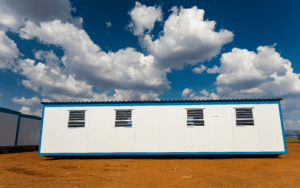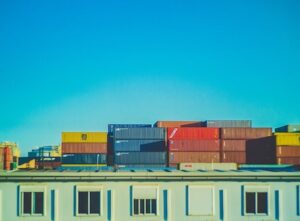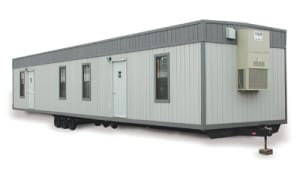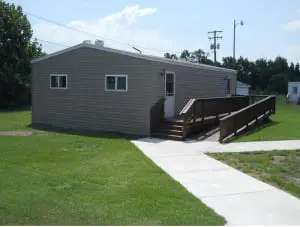
How to Maintain and Care for Your Portable Building
Portable buildings are a versatile and practical solution for a myriad of needs, from temporary offices to permanent living spaces. To ensure they serve you effectively for years to come, proper maintenance and care are essential. In this blog, we’ll explore key tips for maintaining your portable building and how these practices contribute to its longevity and functionality. Toward the end, we’ll also discuss how our portable buildings are designed with durability and ease of maintenance in mind.
Regular Inspection and Cleaning
Routine inspections are crucial in identifying and addressing potential issues before they escalate. Check for any signs of wear and tear, especially after extreme weather conditions. Look out for leaks, cracks, or any structural damages and address them promptly.
Regular cleaning also plays a significant role in maintenance. Keeping the building clean not only makes it a more pleasant space to use but also prevents the build-up of dirt and debris that can cause long-term damage.
Detailed Inspection Guidelines
A thorough inspection of your portable building should be conducted periodically. This process involves several key areas:
- Structural Integrity: Check the entire structure for any signs of damage. Look for dents, cracks, or rust, especially in metal buildings. Pay attention to the roof and flooring for any warping, leaks, or weak spots.
- Windows and Doors: Inspect windows and doors to ensure they are sealing properly. Check for gaps, damaged seals, or cracks in the glass, as these can lead to water ingress and energy inefficiency.
- Exterior Surfaces: Examine the exterior walls for any signs of wear, paint chipping, or moisture damage. In wood structures, look out for signs of rot or pest infestation.
- Foundation and Undercarriage: If accessible, inspect the foundation and undercarriage of the building for stability, rust, or deterioration. Any sinking or tilting should be addressed immediately.
Cleaning Best Practices
Regular cleaning not only maintains the aesthetic appeal of your portable building but also contributes to its upkeep. Here are some best practices for cleaning:
- Regular Dusting and Vacuuming: Inside the building, regular dusting and vacuuming can prevent the accumulation of dust and debris, which can affect air quality and the functionality of HVAC systems.
- Wiping Surfaces: Clean all surfaces, including windows, doors, and built-in furniture, with appropriate cleaning agents. For exterior cleaning, use a mild detergent and water, and avoid harsh chemicals that can damage the surface.
- Floor Maintenance: Regularly clean the floors, and immediately address any spills to prevent staining or moisture-related issues. If the building has carpet, consider professional cleaning periodically.
- Mold and Mildew Prevention: In areas prone to moisture, watch out for signs of mold and mildew. Regular ventilation and the use of dehumidifiers can help in prevention.
- Gutter and Drainage Cleaning: If your building has gutters or drainage systems, ensure they are cleaned out regularly to prevent blockages that can lead to water damage.

Addressing Issues Promptly
One of the key aspects of regular inspection is the prompt addressing of any issues discovered. Delaying repairs can lead to more significant problems down the line. Whether it’s a minor sealant application or a more substantial repair, timely action can save both time and money.
Creating a Maintenance Schedule
Develop a maintenance schedule to ensure regular inspections and cleaning are not overlooked. This could be a monthly or quarterly checklist, depending on the building’s usage and location. Keeping records of inspections and any maintenance work done can also be helpful for future reference.
Regular inspection and cleaning are vital for maintaining the condition of your portable building. By adhering to these best practices, you can ensure that your building remains a safe, clean, and functional space. Regular maintenance not only extends the life of the building but also ensures it remains a comfortable and efficient environment for its users.
Weatherproofing and Insulation
Weatherproofing your portable building is vital, particularly if it’s exposed to harsh weather elements. Ensure that the roof, windows, and doors are properly sealed and waterproofed. Good insulation not only helps in regulating the temperature inside the building but also protects against moisture, which can lead to mold and mildew.
In the lifecycle of a portable building, weatherproofing and insulation are key factors that play a significant role in its durability and functionality. These elements are crucial not just for comfort but also for protecting the building from environmental elements. Proper maintenance in these areas ensures that your portable building remains a reliable and efficient space, regardless of the weather conditions.
The Importance of Weatherproofing
Weatherproofing involves protecting the building from water, wind, and other environmental factors that can cause damage over time.
- Sealant Checks: Regularly inspect and maintain the sealants around windows, doors, and any other openings. Over time, sealants can deteriorate, leading to leaks and drafts. Reapplying sealant as needed can prevent water ingress and energy loss.
- Roof Maintenance: The roof should be inspected regularly for signs of wear, leaks, or damage. Promptly repairing any issues is essential to prevent water damage inside the building.
- Wall and Exterior Care: Check the exterior walls for any cracks, holes, or signs of damage. Repairing these promptly can prevent further deterioration due to moisture or pests.
Insulation Maintenance
Insulation is vital for maintaining a comfortable interior temperature and reducing energy costs.
- Inspection and Replacement: Inspect the insulation periodically to ensure it is still in good condition and performing effectively. Look for signs of moisture, which can reduce its effectiveness and potentially lead to mold growth.
- Upgrades for Efficiency: Over time, insulation technology may improve, or the insulation may settle and become less effective. Upgrading or replacing insulation can be a cost-effective way to improve energy efficiency and comfort within the building.
- Addressing Gaps: Over time, buildings may shift or settle, leading to gaps in insulation coverage. Filling these gaps can help maintain consistent temperatures and reduce energy costs.

Combating Condensation
In portable buildings, condensation can be a significant issue, especially in environments with high humidity or large temperature variations.
- Ventilation Systems: Ensure that your building has adequate ventilation to allow moisture to escape and reduce the likelihood of condensation. This might involve the installation of vents or the use of dehumidifiers.
- Moisture Barriers: In some cases, installing moisture barriers can help prevent condensation within wall cavities and other hidden areas.
Regular Checks for Weather-Related Damage
Weather conditions can be unpredictable, and their impact on portable buildings can be significant. After severe weather events, conduct thorough inspections to identify and address any damage caused. This proactive approach can prevent minor damage from turning into major issues.
Maintaining the weatherproofing and insulation of your portable building is crucial for ensuring its longevity and functionality. Regular checks and maintenance not only safeguard the building against environmental damage but also contribute to a comfortable and energy-efficient environment for its occupants. Keeping these aspects of your portable building in top condition is a smart investment in its overall value and utility.
HVAC Maintenance
If your portable building is equipped with heating, ventilation, and air conditioning (HVAC) systems, regular maintenance is key. This includes cleaning or replacing air filters, checking thermostats, and ensuring that the system is running efficiently. Proper HVAC maintenance not only ensures a comfortable environment but also prolongs the life of the system and reduces energy costs.
Pest Control
Regular pest control is essential to protect your portable building from potential infestations. Pests can cause significant damage to the structure and create an unhealthy environment. Regular checks and preventive treatments can help keep this issue at bay.
Ground and Foundation Care
Ensure that the ground and foundation where your portable building is placed are stable and in good condition. Over time, shifts in the ground can affect the building’s stability. Regular checks and adjustments may be necessary to keep the building level and secure.
Addressing Plumbing and Electrical Systems
For portable buildings with plumbing and electrical systems, regular checks are important to prevent malfunctions. Ensure that all plumbing is in good working order and that there are no leaks. Electrical systems should be inspected for any signs of damage or wear, and repairs should be carried out by a qualified professional.
Paint and Exterior Care
Maintain the exterior of your portable building by keeping it painted and treated against rust and corrosion, especially if it’s made of metal. This not only enhances its appearance but also adds an extra layer of protection against the elements.

The exterior of a portable building not only defines its aesthetic appeal but also plays a crucial role in its protection and longevity. Regular maintenance of the paint and exterior surfaces is essential in preserving the building’s structural integrity and appearance. In this section, we’ll explore the best practices for maintaining the paint and exterior of your portable building.
Importance of Exterior Maintenance
The exterior of a portable building is constantly exposed to environmental elements like sun, rain, wind, and possibly snow. Over time, these elements can take a toll on the building’s exterior, leading to wear and tear that not only affects its appearance but can also lead to more serious damage. Regular maintenance and care of the exterior are crucial in protecting the building against these elements.
Paint Maintenance
- Regular Inspection: Regularly inspect the paintwork for signs of peeling, cracking, or fading. These can be early indicators of exposure damage and should be addressed promptly to prevent further deterioration.
- Choosing the Right Paint: When repainting is necessary, choosing high-quality, weather-resistant paint is crucial. These paints are specifically formulated to withstand harsh weather conditions and provide long-lasting protection.
- Proper Application: Ensure that the paint is applied correctly. This might involve cleaning and priming the surface before painting. Proper application not only enhances the building’s appearance but also extends the life of the paint job.
Addressing Rust and Corrosion
For metal portable buildings, rust and corrosion are common concerns.
- Regular Checks: Inspect for any signs of rust or corrosion, particularly in areas where water might collect or where the paint has been compromised.
- Prompt Treatment: If rust is found, treat it immediately. This typically involves sanding the affected area, applying a rust-inhibiting primer, and then repainting.
- Preventive Coatings: Using rust-preventive coatings can significantly reduce the risk of corrosion, especially in humid or coastal environments.
Cleaning and Washing
Keeping the exterior of your portable building clean not only maintains its appearance but also helps in identifying any potential issues.
- Gentle Cleaning: Regularly clean the exterior with gentle methods. High-pressure washing can be damaging, especially for wood or painted surfaces. Instead, use a soft brush and mild soapy water.
- Mold and Mildew Removal: In damp environments, check for mold and mildew growth on the exterior. These should be cleaned promptly as they can cause damage over time.
Protecting Wood Exteriors
If your portable building is made of wood, it requires additional care.
- Sealing and Staining: Wood exteriors should be regularly sealed or stained to protect them from moisture and UV damage.
- Checking for Pests: Regularly inspect for signs of pests like termites or carpenter ants, which can cause significant damage to wood structures.
Proper maintenance and care are the keys to maximizing the lifespan and functionality of your portable building. Regular checks, cleaning, and timely repairs can prevent major issues and ensure that your building remains a reliable and efficient space.
At Used Construction Trailers, we understand the importance of durability and ease of maintenance in portable buildings. If your journey to proper maintenance and care for your portable building leads you to learning more or getting a quote for our high-quality portable buildings we are prepared to get you connected. We’re here to help you find the perfect solution tailored to your specific requirements.

Leave a Reply